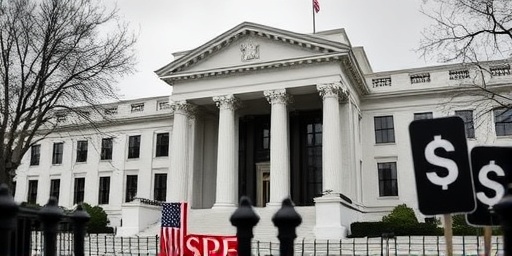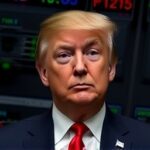Prolonged Government Shutdown Hits Federal Workers and Supply Chains Hard
In a stark illustration of fiscal gridlock, the US economy is reeling from a government shutdown now entering its third week, leaving over 800,000 federal workers without paychecks and disrupting essential services nationwide. This impasse, sparked by partisan disagreements over border security funding, has already cost the economy an estimated $1.5 billion per week in lost productivity, according to the Congressional Budget Office. As families of furloughed employees scramble to cover bills, the ripple effects are felt across sectors from national parks to air traffic control, amplifying concerns about the broader health of the US economy.
- Prolonged Government Shutdown Hits Federal Workers and Supply Chains Hard
- Inflation Surges for Fifth Consecutive Month, Fueling Cost-of-Living Crisis
- Federal Reserve Debates Rate Cuts Amid Mixed Economic Signals
- GDP Growth Forecasts Downgraded as Headwinds Mount
- Outlook: Pathways to Recovery and Lingering Risks for the US Economy
The shutdown’s impact extends beyond immediate payroll disruptions. Small businesses reliant on federal contracts, particularly in defense and research, report delayed payments totaling billions, stalling investments and hiring. ‘We’re seeing a chilling effect on economic activity,’ said Mark Zandi, chief economist at Moody’s Analytics. ‘The uncertainty is prompting businesses to hold back on expansion plans, which could shave as much as 0.2 percentage points off GDP growth in the first quarter.’ With holiday spending season approaching, consumer confidence is waning, as polls from the Conference Board show a sharp 5-point drop in its index last month.
Federal agencies like the IRS are scaling back operations, potentially delaying tax refunds for millions and further straining household budgets. In coastal states, Coast Guard personnel working without pay are patrolling waterways, but the morale hit could lead to long-term talent drain. Economists warn that if the shutdown persists into December, it might trigger a mild recessionary signal, echoing the 2018-2019 shutdown’s $11 billion toll.
Inflation Surges for Fifth Consecutive Month, Fueling Cost-of-Living Crisis
Compounding the shutdown woes, inflation in the US economy ticked up to 3.7% year-over-year in October, marking the fifth straight monthly increase and dashing hopes for a swift cooldown. Driven by persistent supply chain bottlenecks and renewed energy price spikes, the Consumer Price Index (CPI) rose 0.4% from September, outpacing economists’ expectations of 0.3%. Core inflation, excluding volatile food and energy, held steady at 4.1%, signaling deep-rooted pressures in housing and services.
Everyday Americans are bearing the brunt: grocery prices have jumped 5.2% annually, with staples like eggs and bread up over 10%. Gasoline, while down from summer peaks, remains 15% higher than pre-pandemic levels, hitting commuters in sprawling suburbs hardest. ‘Inflation is eroding the purchasing power of middle-class families at a time when they can least afford it,’ noted Federal Reserve Chair Jerome Powell in recent testimony. The surge is partly blamed on the government shutdown, which has idled customs inspectors and slowed imports, exacerbating shortages in electronics and apparel ahead of Black Friday.
Regional disparities are stark. In the Midwest, manufacturing hubs like Detroit face input costs up 6%, squeezing auto suppliers already battered by strikes. Urban centers like New York see rent inflation at 4.8%, pushing more residents into financial distress. The Federal Reserve’s preferred gauge, the Personal Consumption Expenditures (PCE) index, is expected to follow suit, potentially complicating monetary policy. With wage growth lagging at 4.0%, real incomes are declining, prompting warnings from the Labor Department about rising underemployment.
Federal Reserve Debates Rate Cuts Amid Mixed Economic Signals
The Federal Reserve finds itself in a precarious bind as it contemplates further interest rate cuts against the backdrop of escalating inflation and a grinding government shutdown. After slashing rates by 50 basis points in September to bolster the cooling job market, the central bank now faces projections of subdued GDP growth, with uncertainty clouding its December meeting. Fed officials, in minutes from their latest session, expressed ‘divided views’ on the pace of easing, with some advocating caution to avoid reigniting inflationary fires.
Market watchers are glued to upcoming jobs data, which showed nonfarm payrolls adding a tepid 114,000 positions last month—below forecasts and signaling slowdown. Unemployment ticked up to 4.1%, the highest since late 2021, partly due to federal furloughs. ‘The Fed is walking a tightrope,’ said economist Lisa Cook of the Fed’s Board of Governors. ‘We need to support the US economy without letting inflation spiral further.’ Bond yields have fluctuated wildly, with the 10-year Treasury dipping below 4% amid safe-haven buying, reflecting investor jitters over fiscal policy paralysis.
Internationally, the Fed’s moves ripple outward. The European Central Bank has paused hikes in solidarity, but emerging markets like Brazil suffer capital outflows as US rates remain relatively high. Analysts at Goldman Sachs predict a 25-basis-point cut in December if shutdown resolution appears imminent, but prolonged stalemate could force a hawkish pivot. Crypto markets, sensitive to Fed signals, have seen Bitcoin hover around $60,000, buoyed by easing expectations but vulnerable to volatility.
GDP Growth Forecasts Downgraded as Headwinds Mount
Wall Street’s optimism is fading fast, with major forecasters slashing GDP growth projections for the US economy in light of the government shutdown and stubborn inflation. The Atlanta Fed’s GDPNow model now estimates Q4 growth at just 1.2%, down from 2.1% a month ago, factoring in reduced government spending and consumer pullback. Similarly, the IMF has trimmed its 2024 US forecast to 2.5% from 2.9%, citing ‘policy uncertainty’ as a key drag.
Corporate earnings reflect the strain: third-quarter S&P 500 reports showed 72% beating estimates, but forward guidance was gloomy, with mentions of ‘shutdown risks’ up 40% in transcripts. Tech giants like Amazon warn of logistics disruptions, while retailers like Walmart brace for softer holiday sales amid inflation-weary shoppers. The manufacturing PMI dipped to 47.8 in October, indicating contraction for the first time in six months, as factory orders tied to federal projects evaporate.
Sector-specific pain is evident. Construction, reliant on public infrastructure funds, saw a 0.3% output drop, per Census Bureau data. Tourism suffers as Smithsonian museums and national monuments remain shuttered, costing $200 million daily in lost revenue. Energy firms report delayed permitting, hindering drilling amid global demand. ‘These downgrades aren’t alarmist; they’re realistic,’ opined JPMorgan’s Michael Feroli. ‘Without bipartisan action, we could see sub-1% growth by mid-2024.’
Outlook: Pathways to Recovery and Lingering Risks for the US Economy
As the US economy navigates these turbulent waters, the path forward hinges on swift resolution to the government shutdown and decisive Federal Reserve action. Bipartisan talks in Congress show tentative progress, with a potential deal on border funding by week’s end that could reopen agencies and restore paychecks. If achieved, economists like those at Oxford Economics project a rebound, with GDP growth accelerating to 2.8% in 2024 as pent-up spending unleashes.
Yet risks abound. Prolonged inflation could force the Fed to hike rates again, stifling borrowing and investment. Geopolitical tensions, including Middle East conflicts driving oil prices, add upward pressure on energy costs. Labor markets, while resilient, face strikes in auto and rail sectors, potentially idling 150,000 more workers. The Treasury Department’s debt ceiling looms in January, risking another crisis if not addressed.
Positive glimmers include robust consumer savings rates at 3.8% and AI-driven productivity gains in tech. States like Texas, with diversified energy exports, are buffering national slowdowns. Policymakers urge fiscal stimulus, such as backpay guarantees for feds, to mitigate damage. International allies, via G20 forums, call for US stability to anchor global growth. Ultimately, the resilience of the US economy will be tested, but history suggests adaptability—provided political will prevails. Stakeholders from Wall Street to Main Street await clarity, poised for either stabilization or deeper downturn.









